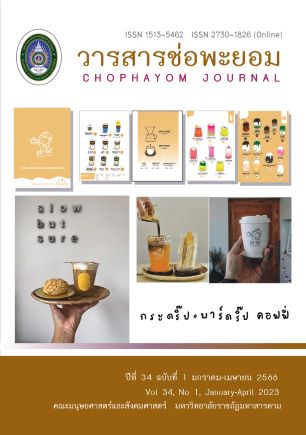Motivation and Branding Influencing Behavioral Intentions of Wellness Tourism in Maha Sarakham Province
Keywords:
Tourists’Motivation, Tourism Branding, Behavioral Intention, Wellness TourismAbstract
This research aims to investigate 1) the motivation of wellness tourists in Maha Sarakham Province, 2) the behavioral intentions on Wellness Tourism in Maha Sarakham Province, and 3) the causal relationship between tourists' motivation and tourism brands and their behavioral intentions on Wellness Tourism in Maha Sarakham Province. The population sample consists of 400 Thai visitors, and questionnaires were used to gather data. Utilizing the Confirmatory Factor Analysis (CFA) technique, frequency, percentage, standard deviation, mean, and weighted mean were assessed as part of the data analysis. The findings indicated that visitors' motivation has a negative effect on their tourism-related behavioral intentions (= -.340, p < .01), which implies that if tourists are more motivated, it may lead to a decrease in their tourism-related behavioral intentions in Maha Sarakham Province. While the rise in positive tourism brand awareness among tourists will result in an increase in their tourism-related behavioral intentions, the increase
in positive tourism brand awareness among tourists will result in a decrease in their In other words, if visitors see the tourism brand in a more favorable light, their desire to engage in tourism-related activity will certainly grow (= -.340, p < .01) . Keywords: Tourists’Motivation, Tourism Branding, Behavioral Intention, Wellness Tourism
References
Alana, K., et al. (2020). Dimensions of holistic wellness as a result of international wellness tourism experiences, Current Issues in
Tourism. Current Issues in Tourism, 31(1), 1–17.
Bank of Thailand. (2022). New tourism landscape: Enhancing competitive edges and creating new values. [Online]. Retrieved
January 31, 2022 fromhttps://www.bot.or.th/Thai/ResearchAndPublications/articles/Pages/Article_18Aug 2 021.aspx
Buchan, E. & Brown, A. (1989). “Mergers and Acquisitions,” in Brand Valuation—Establishing a True and Fair View, Murphy,
John , ed. London: Hutchinson Business Books, 80–93.
Chatchalermkit, A. (2022). TAT sets a flag to speed up the promotion of tourism products "Health and Wellness" to receive new
trends and welcome tourists from around the world. [Online]. Retrieved January 31, 2022 from https://www. thansettakij.
com/business/511743.
Dann, Graham M.S. (1981). Tourist motivation an appraisal. Annals of Tourism Research, 8 (2), 187-219.
Hsiang-Ming, L., Ching-Chi, L., & Cou-Chen, W. (2011). Brand image strategy affects brand equity after M&A. European Journal
of Marketing, 45(8), 1091-1111.
Hui, T.K. (2009). Tourists’ satisfaction, recommendation and revisiting Building a model of local food consumption on trips Singapore.
Tourism Management, 28(4), 965-975.
Isichaikul, R. (2014). Niche Tourism Management. Nonthaburi:Sukhothai Thammathirat University Press.
Kuo, P. (2011). Tourism Demand Forecasting Using Novel Hybrid System. Expert Systems with Applications, 3691-3702.
Leong Q. (2010). Relationships Between Malaysian Food Image, Tourist Satisfaction and Behavioural Intention. World Applied Sciences
Journal, 10 (1), 164-171.
Loredana D. & Francesca D. (2011). Social network for the choice of tourist destination: attitude and behavioral intention. Journal
of Hospitality and Tourism Technology, 3 (1),60-76.
Mak, A. (2011). An identity-centered approach to place branding: Case of industry partners' evaluation of Iowa's destination image.
Journal of Brand Management, 18(6), 438-450.
Martaleni, M., et al. (2021). Role of tourist motivation as mediating variable on visitor decisions at Indonesian tourism village. Innovative Marketing, 17(3), 88-98.
Oppermann, M. (2000). Predicting destination choice: A discussion of destination loyalty. Journal of Vacation Marketing, 51-65.
Pereira R. (2012). Destination Branding: A Critical Overview. Journal of Quality Assurance in Hospitality & Tourism, 13(2),81-102.
Phiwat Thai Public Health Foundation. (2017). Thai Herb Town Master Plan. Bangkok: Phiwat Thai Public Health Foundation.
Purasakul, L.(2019). Assessing Chinese tourists’ satisfaction with their shopping experiences in Bangkok. Journal of China Tourism
Research, 15(4), 2-15.
Rovinelli, R.J. & Hambleton, R.K. (1977). On the use of content specialists in the assessment of criterion-referenced test item
validity Dutch. Journal of Educational Research, 2, 49-60.
Sadeh, E., et al. (2012). Factors Affecting Tourist Satisfaction. Journal of Hospitality and Tourism Management, 1-20.
Saleem, S., Rahman, S. U., & Umar, R. M.(2015). Measuring Customer Based Beverage Brand Equity: Investigating the Relationship
between Perceived Quality, Brand Awareness, Brand Image, and Brand Loyalty. International Journal of Marketing Studies, 7(1), 66-77.
Sangpikul, A. (2008). Travel motivations of Japanese senior travelers to Thailand. International Journal of Tourism Research, 10(1), 81-94.
Steven, J.P. (2009). Applied multivariate statistics for the social sciences. New York: Routledge.
Silcharu, T. (2017). Research and statistical analysis with SPSS and AMOS.Bangkok: Business R & D Publishing House.
Tasci, A., et al. (2007). Conceptualization and Operationalization of destination. Journal of Hospitality & Tourism Research, 31(2),
-223.
Tourism Authority of Thailand. (2022). Trends in health tourism. [Online]. Retrieved January 31, 2022 from https://www.thansettakij.com/business/511743
Wanichbancha, K. (2011). Statistical analysis: statistics for decision making. Bangkok: Chulalongkorn University Press.
Wiratchai, N. (1999). Lisrail model, analytical statistics for research. 3rd Edition. Bangkok: Chulalongkorn University Press.
Yamaguchi, S., et al. (2015). Assessing the Effects of Service Quality, Past Experience, and Destination Image on Behavioral Intentions in the Spring Training Camp of a Japanese Professional Baseball Team. Journal of Convention & Event Tourism, 16(3), 66-77.
Downloads
Published
How to Cite
Issue
Section
License
Copyright (c) 2023 Chophayom Journal

This work is licensed under a Creative Commons Attribution-NonCommercial-NoDerivatives 4.0 International License.






